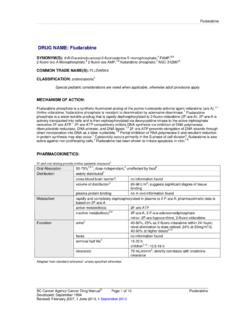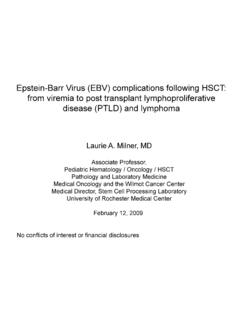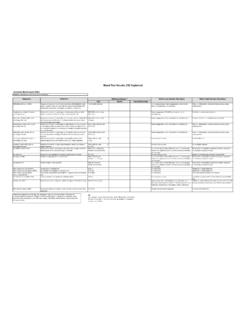Transcription of BCCA Protocol Summary for Treatment of Chronic …
1 BCCA Protocol Summary for Treatment of Chronic Lymphocytic leukemia (CLL) or prolymphocytic leukemia with fludarabine , cyclophosphamide and riTUXimab Protocol Code LYFCR Tumour Group Lymphoma Contact Physician Dr. Laurie H. Sehn Dr. Alina Gerrie ELIGIBILITY: fludarabine -RiTUXimab (LYFLUDR) remains the recommended standard initial therapy for Treatment of CLL or prolymphocytic leukemia FCR (LYFCR) is recommended at time of initial need for systemic Treatment in patients with CLL or prolymphocytic leukemia 11q deletion on FISH testing Select patients with other high risk features based on physician discretion, such as high tumor bulk or aggressive behaving disease Patients must be appropriate candidates for FCR as follows: Age less than or equal to 65 and excellent health and performance status ECOG 0-1 with no co-morbid illness. Note that some clinical trials have used a modified Cumulative Illness Rating Scale (CIRS) score of up to 6 to help determine eligibility for FCR.
2 While this is not a requirement, the CIRS score is provided in Appendix 1 for reference. TESTS: Baseline (required before first Treatment ): CBC & diff, platelets, serum creatinine, bilirubin, AST, ALT, LDH Baseline (required, but results do not have to be available to proceed with first Treatment ; results must be checked before proceeding with further Treatment ): HBsAg, HBcoreAb, CLL specific FISH should be performed prior to therapy (to include del 13q, +12, del 11q and del 17p) Before each Treatment : CBC & diff, platelets, serum creatinine PREMEDICATIONS: No premedication is required for fludarabine For cyclophosphamide : ondansetron 8 mg PO and dexamethasone 8 mg PO once daily pre-chemotherapy For riTUXimab portion For intravenous infusion: diphenhydrAMINE 50 mg PO prior to riTUXimab IV and then q 4 h during the IV infusion, if the infusion exceeds 4 h acetaminophen 650-1000 mg PO prior to riTUXimab IV and then q 4 h during the IV infusion, if the infusion exceeds 4 h For subcutaneous injection: diphenhydrAMINE 50 mg PO prior to riTUXimab SC acetaminophen 650-1000 mg PO prior to riTUXimab SC SUPPORTIVE MEDICATIONS.
3 If HBsAg or HBcoreAb positive, start lamiVUDine 100 mg/day PO for the duration of chemotherapy and for six months afterwards. BC Cancer Agency Protocol Summary LYFCR Page 1 of 6 Activated: 1 Jul 2014 Revised 1 Nov 2017 (Subcutaneous rituximab) Warning: The information contained in these documents are a statement of consensus of BC Cancer Agency professionals regarding their views of currently accepted approaches to Treatment . Any clinician seeking to apply or consult these documents is expected to use independent medical judgement in the context of individual clinical circumstances to determine any patient's care or Treatment . Use of these documents is at your own risk and is subject to BC Cancer Agency's terms of use available at Treatment : Drug Dose BCCA Administration Guideline fludarabine 40 mg/m2/day x 3 consecutive days (Day 1-3) (round dose to nearest 10 mg) PO Do not chew, break or crush the tablets. cyclophosphamide 250 mg/m2/day x 3 consecutive days (Day 1-3) (round dose to nearest 25 mg ) PO Dividing drug into 2-3 subdoses each day may improve tolerance 375 mg/m2 on day 1 NOTE: riTUXimab, cyclophosphamide and fludarabine to start on the same day.
4 IV in 250 mL NS over 1 hour 30 minutes to 8 hours* (doses between 500-1000 mg can be prepared in either 250 mL or 500 mL NS) riTUXimab** If first IV infusion tolerated (no severe reactions requiring early termination), subsequent doses can be given by SC administration 1400 mg (fixed dose in mL) on day 1 NOTE: riTUXimab, cyclophosphamide and fludarabine to start on the same day. SC over 5 minutes into abdominal wall Observe for 15 minutes after administration If PO fludarabine and / or cyclophosphamide is not practical, substitute IV fludarabine and / or cyclophosphamide according to the following schedule: Drug Dose BCCA Administration Guideline fludarabine 25 mg/m2/day x 3 consecutive working weekdays (day 1-3) NOTE: riTUXimab to be given within 72 h of IV fludarabine and cyclophosphamide IV in 50 to100 mL NS over 20 to 30 minutes cyclophosphamide 250 mg/m2/day x 3 consecutive working weekdays (days 1-3) IV in 100 mL NS over 20 minutes to 1 hour *Start the riTUXimab (first dose) initial infusion at 50 mg/h and, after 1 hour, increase by 50 mg/h every 30 minutes until a rate of 400 mg/h is reached.
5 For all subsequent treatments, infuse 50 mL of 250 mL bag (or 100 mL of 500 mL bag) of the dose over 30 minutes then infuse the remaining 200 mL of 250 mL bag (or 400 mL of 500 mL bag) (4/5) over 1 hour (total infusion time = 1 hour 30 minutes). Development of an allergic reaction may require a slower infusion rate. See hypersensitivity below. ** The risk of cytokine release syndrome is low but is increased when the peripheral blood lymphocyte count is greater than 30 to 50 x 109/L. While there is no requirement to withhold riTUXimab based on the lymphocyte count, clinicians may wish to pre-medicate patients with high tumour burden with steroids prior to riTUXimab infusion or omit the riTUXimab from the first cycle of Treatment . Patients must receive first dose by IV infusion (using the IV formulation) because the risk of reactions is highest with the first infusion. IV administration allows for better management of reactions by slowing or stopping the infusion.
6 During Treatment with subcutaneous riTUXimab, administer other subcutaneous drugs at alternative injection sites whenever possible. BC Cancer Agency Protocol Summary LYFCR Page 2 of 6 Activated: 1 Jul 2014 Revised 1 Nov 2017 (Subcutaneous rituximab) Warning: The information contained in these documents are a statement of consensus of BC Cancer Agency professionals regarding their views of currently accepted approaches to Treatment . Any clinician seeking to apply or consult these documents is expected to use independent medical judgement in the context of individual clinical circumstances to determine any patient's care or Treatment . Use of these documents is at your own risk and is subject to BC Cancer Agency's terms of use available at Repeat every 28 days to a maximum of 6 cycles. DOSE MODIFICATIONS: 1. Hematologic: ANC (x 109/L)* Platelets (x 109/L)* fludarabine , cyclophosphamide and riTUXimab less than OR less than 100 Delay until count recovery* *Consider decreasing fludarabine and cyclophosphamide by 25% each for subsequent cycles, after delay following count recovery.
7 No dose reduction required if decreased counts are due to disease. 2. Renal Dysfunction: For any patient with a serum creatinine above normal and for all patients above the age of 60 years, a creatinine clearance should be measured or calculated using the following formula to determine the initial dose of fludarabine . Estimated creatinine clearance (in mL/minute) = For men: [ x (140-age in y)(weight in kg)] serum creatinine in micromol/L For women: [ x (140-age in y)(weight in kg)] serum creatinine in micromol/L Creatinine Clearance (mL/min) Dose fludarabine Actual Dose and Schedule (Note change in number of days) PO IV greater than 70 100% 40 mg/m2/day x 3 days 25 mg/m2/day x 3 days 30 70 50% 20 mg/m2/day x 3 days 15 mg/m2/day x 3 days less than 30 DO NOT USE After the first cycle, it is not necessary to re-calculate the creatinine clearance or to re-adjust the fludarabine or cyclophosphamide dose unless the serum creatinine is above the normal range.
8 If this occurs, use the above calculation and dose modification table. If a reduced dose of fludarabine was used for initial Treatment and well tolerated it may be appropriate for the dose to be increased in subsequent cycles regardless of renal function. This decision must be individualized by the treating oncologist and cannot be reduced to a formula. PRECAUTIONS: 1. Neutropenia: Fever or other evidence of infection must be assessed promptly and treated aggressively. A very high risk of hematologic toxicity including neutropenia, febrile episodes and infection (bacterial) has been reported with use of FCR. Patients should be counselled to seek medical attention promptly for fever or symptoms of infection. Prophylaxis with cotrimoxazole DS 1 tab po BID every Monday and Thursday for pneumocystis and with valacyclovir 500 mg PO daily for VZV/HSV reactivation is recommended. Prophylaxis should be continued for three months after completion of therapy.
9 2. Tumor Lysis Syndrome: Prophylaxis for tumour lysis syndrome with allopurinol 300 mg daily is recommended for cycle 1. The need for allopurinol beyond cycle 1 to be determined by the treating physician. BC Cancer Agency Protocol Summary LYFCR Page 3 of 6 Activated: 1 Jul 2014 Revised 1 Nov 2017 (Subcutaneous rituximab) Warning: The information contained in these documents are a statement of consensus of BC Cancer Agency professionals regarding their views of currently accepted approaches to Treatment . Any clinician seeking to apply or consult these documents is expected to use independent medical judgement in the context of individual clinical circumstances to determine any patient's care or Treatment . Use of these documents is at your own risk and is subject to BC Cancer Agency's terms of use available at 3. Need for irradiated blood products: potentially life-threatening transfusion-related graft-versus-host-disease has been described in patients actively receiving fludarabine .
10 The Canadian Blood Service recommends that patients on fludarabine should receive irradiated blood products, effectively eliminating this risk. 4. Hepatitis B. The immunosuppression associated with fludarabine may increase the risk of re-activation of hepatitis B. Although the risk of this is probably small, fludarabine should be avoided in patients with known prior hepatitis B (HBsAg positive or hepatitis B core antibody positive) unless the clinical situation justifies this increased risk and this has been explained to the patient. 5. Hepatitis B Reactivation: All lymphoma patients should be tested for both HBsAg and HBcoreAb. If either test is positive, such patients should be treated with lamiVUDine during chemotherapy and for six months afterwards. Such patients should also be monitored with frequent liver function tests and hepatitis B virus DNA at least every two months. If the hepatitis B virus DNA level rises during this monitoring, management should be reviewed with an appropriate specialist with experience managing hepatitis and consideration given to halting chemotherapy.

















